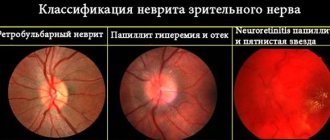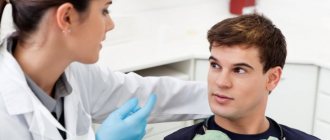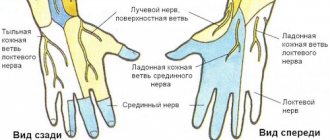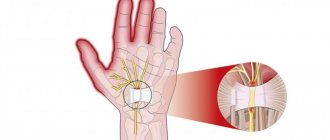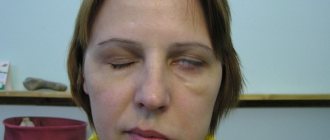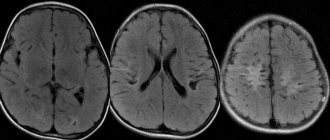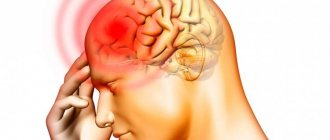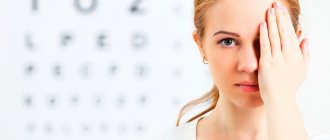There are several types of lesions of the facial nerve, the most famous of which are the following: neuritis of the facial nerve, inflammation of the knee ganglion, Rossolimo-Melkersson syndrome, clonic hemifacial spasm, facial myocomia.
What are the symptoms of Bell's palsy, what are the causes of the disease, and how to treat it? Details are in the article.
What is facial neuritis and disease code according to ICD-10
Neuritis (inflammation, neuropathy) of the facial nerve (Bell's palsy, facial paralysis) is the most common idiopathic form of paralysis.
The disease is characterized by degenerative changes in the nerve, leading to disruption of the innervation of facial muscles . Complete or partial damage to the nerve is possible.
In the International Classification of Diseases (ICD-10), Bell's palsy is coded G51.0 and is a subdivision of G51 (Facial nerve lesions).
According to WHO, the prevalence of facial neuritis is 13-24 cases per 100,000 population and ranks second among pathologies of the peripheral nervous system after vertebrogenic diseases.
In children, LPN is the most common form of damage to the peripheral nervous system. It accounts for more than 90% of all mononeuropathies occurring in childhood.
Most often, people aged 25-60 years suffer from inflammation of the facial nerve.
There are two types of neuritis of the facial nerve:
What does it represent?
Have you been trying to heal your JOINTS for many years?
Head of the Institute for the Treatment of Joints: “You will be amazed at how easy it is to cure your joints by taking the product every day for 147 rubles ...
Read more "
Brachial neuritis is a condition of sudden pain in the shoulder and arm , accompanied by weakness or numbness.
OUR READERS RECOMMEND!
Our readers successfully use Sustalaif to treat joints. Seeing how popular this product is, we decided to bring it to your attention. Read more here...
Caused by inflammation of the brachial plexus, formed by a combination of nerve roots emerging from the cervical spine into the neck.
Although the intense pain usually subsides within a few days, it is followed by some numbness and weakness in the arm and/or shoulder that may last for many months.
Causes of primary and secondary inflammation in adults and children
Primary:
- viral infection (herpes causes herpetic neuritis of the facial nerve, varicella zoster virus, mumps, cytomegalovirus, coxsackievirus infection, etc.);
- hypothermia;
- contact with toxic substances: mercury, arsenic, lead, etc.
- facial nerve damage.
Secondary:
- traumatic brain injury;
- fracture of the base of the skull;
- arthritis;
- malignant brain tumor;
- circulatory disorders of the facial nerve;
- hypertensive crisis;
- cerebrovascular accident (stroke);
- infarction of the cerebral hemispheres;
- intracerebral hematoma of the cerebral hemispheres with arterial hypertension, hemophilia, atherosclerosis;
- abscess of the cerebral hemispheres;
- diabetes;
- atherosclerosis;
- multiple sclerosis;
- encephalitis;
- inflammation of the facial nerve after wisdom tooth removal.
Specific factors of occurrence in a child
Primary:
- birth injury;
- hypothermia;
- viral infection.
Secondary:
- TBI;
- malignant brain tumor.
Psychosomatics of the disease
In official medicine, there is also a version about the psychosomatic causes of the disease.
These include:
- strenuous effort to control anger;
- reluctance to express your feelings;
- internal duality;
- carefully hidden internal conflict;
- lack of self-control.
Types of brachial plexopathy
The human shoulder, when viewed as a collection of joints, muscles and nerves, is a rather complex structure. Accordingly, doctors distinguish several types of brachial plexus plexopathy:
- Erb's syndrome (deltoid palsy), also known as obstetric palsy or proximal upper palsy . The main symptom is the inability to move the arm to the side. Appears in newborns due to certain actions of the obstetrician during childbirth. These actions are taken only in the case when the child cannot “come out” on his own, and it is no longer possible to use the cesarean section method. Accordingly, the obstetrician must help the child take the correct position. In this case, stretching of the upper trunk of the brachial plexus and injury to the scalene muscles may occur. But this is only one of the reasons for its appearance, although the most common. Other, less common causes include shoulder injuries resulting from a strong blow from above or a strong pull on the arm, or penetrating wounds to the brachial plexus. Treatment of the disease begins with conservative methods - painkillers, drugs to improve blood supply and drugs to improve the conduction of nerve impulses. Physiotherapy (electrophoresis or UHF) helps well. Don’t forget about regular exercise therapy.
- Biceps paralysis . The main symptom is the inability or difficulty in bending the arm at the elbow joint.
- Paralysis of the supraspinatus and infraspinatus muscles . The main symptom is that since these muscles are located in the area of the shoulder blades, their damage or loss of mobility makes movements such as straightening the shoulders or straightening the back impossible.
If the case is severe and all the nerves of the shoulder are inflamed (damaged), then complete paralysis of the arm occurs. In this case, atrophy of the arm muscles occurs and its gradual “drying out”. Sensitivity disappears.
Symptoms on the right and left, diagnosis, photos of patients
- Sudden paralysis on one side of the face (most often the disease is detected in the morning, after sleep).
- Inability to completely close the eye.
- Eye irritation (due to dryness caused by lack of blinking) or severe tearing.
- Facial asymmetry: one side of the mouth, one cheek may be lowered or raised.
- Violation (distortion) of facial expressions: a person cannot smile, cannot move his eyebrows, etc.
- Smoothed nasolabial fold.
- Change in taste sensations.
- Increased sound sensitivity.
- Dry mouth.
- Pain in the ear area.
- Headache.
- Difficulties with the pronunciation of individual (mainly consonant) sounds.
The diagnosis is made based on clinical examination . The disease should be differentiated from pathologies with similar symptoms: stroke, migraine, toothache.
If the patient cannot wrinkle his forehead or nose, frown or raise his eyebrows, puff out his cheeks, or close his eyes one by one, then there is no doubt: this is Bell's palsy.
Particular attention is paid to the cause of neuropathy (traumatic, infectious, congenital, metabolic, immunological, autoimmune, neoplastic).
In order to determine the degree of impairment of the motor activity of facial muscles, additional examination methods may be prescribed - electroneuromyography, magnetic resonance imaging, transcranial magnetic stimulation.
The photo shows the faces of patients with Bell's palsy:
Consilium Medicum No. 09 2020 – Trigeminal neuralgia
For citation Hide list Trigeminal neuralgia. Consilium Medicum.
2016; 09: Trigeminal neuralgia - NTN (trigeminal neuralgia, Fothergill's disease, painful tic) - the most common form of paroxysmal facial pain, a chronic disease that occurs with remissions and exacerbations, characterized by attacks of extremely intense shooting, usually unilateral, pain in innervation zones II, III or extremely rarely the first branch of the trigeminal nerve. The prevalence of NTN is quite high and amounts to up to 30–50 patients per 100 thousand population, and the incidence in the world, according to WHO, is in the range of 2–4 people per 100 thousand population [2, 3]. Women are more susceptible - 5 per 100 thousand population, men - 2.7 per 100 thousand. Typical NTN debuts at the 50th anniversary of life, occurring more often on the right - 70%, on the left - 28%, in rare cases it can be bilateral - 2% [4]. VI Diseases of the nervous system (G00–G99) Lesions of individual nerves, nerve roots and plexuses (G50–G59) G50.0 Paroxysmal facial pain syndrome, painful tic G53.0* Neuralgia after herpes zoster (B02.2+) Postherpetic : inflammation of the genu ganglion, trigeminal neuralgia
International classification of headaches [5]:
• primary (idiopathic) NTN (caused by compression of the trigeminal root) • secondary (symptomatic) NTN (manifestation of other central nervous system diseases: multiple sclerosis, tumors, brainstem stroke, etc.)
Etiology
The most common cause of NTN is compression of the trigeminal nerve at the extra- or intracranial level. Intracranial factors: dilated convoluted cerebellar arteries, aneurysms of the basilar artery, space-occupying processes in the posterior cranial fossa, tumors of the cerebellopontine angle.
Extracranial factors: compression in the bone canal through which the nerve passes, associated with its congenital narrowness or acquired as a result of a chronic inflammatory process in adjacent areas (caries, sinusitis), local odontogenic or rhinogenic inflammatory processes.
The development of NTN can be promoted by infectious processes, vascular, endocrine-metabolic and allergic disorders, and much less frequently by demyelination of the trigeminal nerve root in multiple sclerosis [2, 6–8].
Pathogenesis
From the perspective of the “collar pain control” theory of Melzack and Wall (Wall, Melzack.
Gate control theory, 1965), with neuralgia of the V and IX pairs of the cranial nerve, caused by compression of their roots at the entrance to the brain stem, demyelination of fast-conducting (antinociceptive) type A fibers occurs with the appearance of many additional voltage-dependent sodium channels in the demyelinated areas and the formation of contacts of these areas with unmyelinated (nociceptive) type C fibers. This leads to the formation of prolonged and high-amplitude activity of pathologically altered A fibers, which is manifested by painful paroxysms in the face and oral cavity [3].
Typical signs of pain during an attack of NTN:
• Character: paroxysmal, shooting, comparable to an electric current discharge • Localization: definite, not changing for many years, within the zones of innervation of the trigeminal nerve • Direction: pain comes from one area and reaches another • Duration: attack does not exceed 2 minutes ( usually 10–15 s) • Presence of: – refractory period – “light” interval between two separate attacks – trigger zones (areas on the skin of the face and in the oral cavity, mild irritation of which causes paroxysm) – trigger factors (actions that cause pain attacks: washing, brushing teeth, chewing, talking)
• Typical behavior: patients freeze in the position in which they were caught by an attack
Neuralgia of individual branches of the trigeminal nerve:
• Nasociliary (Charlene's neuralgia) – stabbing pain radiating to the central part of the forehead when touching the outer surface of the nostril • Supraorbital – paroxysmal or constant pain in the area of the supraorbital notch and the medial part of the forehead • Lingual nerve – pain in half of the tongue, aggravated by eating and talking • Infraorbital nerve – pain of low intensity, feeling of numbness of the mucous membrane of the upper jaw and infraorbital region
Complications and consequences
The disease is dangerous due to its complications . The most common residual effects include the following:
Lifestyle
For a speedy recovery from neuritis of the facial nerve, you must follow certain rules and recommendations:
- avoid hypothermia and drafts;
- eat food in small portions;
- chew food alternately on both sides of the jaw;
- hold the affected side with your hand;
- secure the affected part of the face with a bandage;
- diversify your diet - the diet should contain protein foods, a large amount of vegetables and fruits, foods containing vitamin B (egg yolk, beef liver, pork, buckwheat, legumes, etc.);
- no smoking;
- give up alcohol;
- sleep on the sore side;
- carry out warming at home (you can use traditional methods, for example, with a bag of heated salt);
- pronounce vowels, labials (b, p) and hissing sounds, the sound p;
- sing.
Neuritis of the facial nerve is not only a physiological, but also an aesthetic problem. A person who has suffered from the disease and suffers from its consequences may encounter social problems, experiencing psychological difficulty in communicating.
Considering that the primary form is most common, the disease is easier to prevent . Strengthen your immune system, avoid exposure to drafts, and avoid hypothermia.


